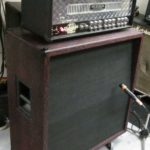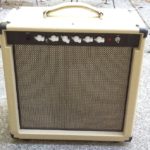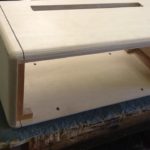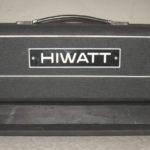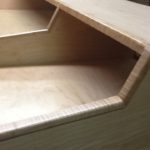Custom Cabinet Building
Early building years: It began with building my own guitar speaker cabinet. After having built many simple rectangular cabinets, I looked into the design of other more complex ones. I wrote away to get a set of plans (no internet back then!) for Altec Lansing Voice of the Theatre Cabinets (in the first picture below) and built them for my home stereo. From there, there were JBLansing 4560’s, Electrovoice Eliminators and many other designs that I played with.

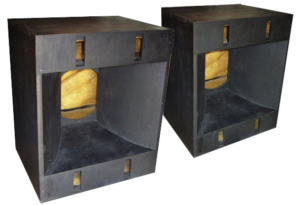

Building low frequency enclosures: I ultimately designed and built my own bass cabinets for my p.a. system. They have 2 Electrovoice 15″ speakers in each, and for my larger festivals, I was running 24 of them All of my front-of-house speakers were covered in grey carpet, which kept them looking very good (and never needing painting!!). Please excuse the bad pictures, but they’re all I have!!


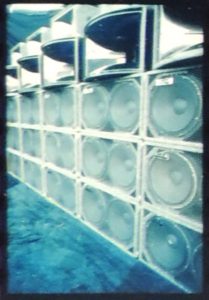
Monitors for my p.a. system: M.I.N.E. floor monitors are designed in mirror-imaged pairs, each with multiple angle possibilities, as well as being able to be used on stands in smaller p.a. applications. The Electrovoice 15″ speaker and high compression driver are very high quality, and the cabinet can handle 400 watts. Large specially-designed dollies for transporting them kept them looking good enough to rarely ever need a fresh coat of paint.



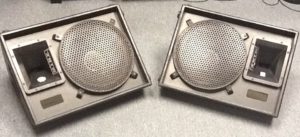

Front-of-house furniture for my p.a. system: A number of years ago, I was fortunate to find a great 3/4″ thick plywood product with bird’s eye maple veneer. All of my sound system racks are made with this beautiful wood, with black edging and an amber clear coat over them. Of course, they all live in flight cases to keep them looking good. I used the same wood to build a “doghouse” (rear compartment) to enclose all of the cabling behind my front-of-house mixing board.

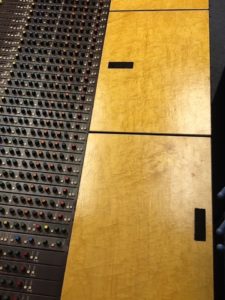
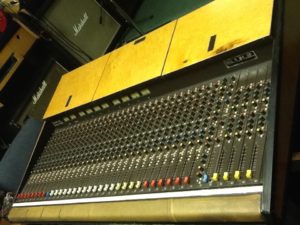
Guitar tech work stations: Many touring acts carry large numbers of instruments, and I have had many requests for multiple-guitar stands and guitar tech work stations. A good friend (who was guitar tech for 5440 at the time) and I designed a guitar tech work station. It incorporated a 6-guitar stand in the top and below it, a series of drawers for supplies and tools (second picture). It also has a neck support and a body tray which hold the guitar being worked on (third picture). Inside the lid, it had a pin-board with rope light installed around it for set-lists, etc. These were made in various configurations for a number of Canada’s top recording/touring acts. One act, who bought two 8-guitar work stations had me install almost $400 worth of various lighting in each case, all on dimmers, so they could blackout in their side-stage location along with the band’s light show.
I also make multiple stands (commonly called guitar boats) (4th and 5th pictures). One touring act who already had 4 guitar boats wanted a small version for 3 Ukeleles, so I created a “u-boat” for them.

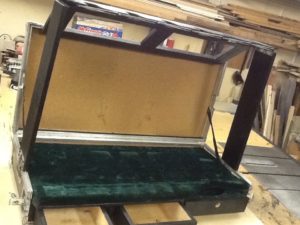
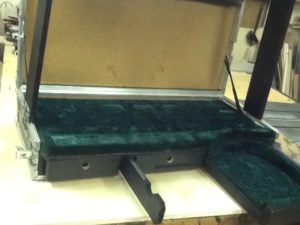

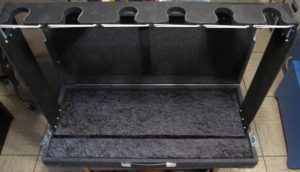

Custom Cabinet: 6 or 7 years ago, I had a request to build the largest cabinet I’ve ever done. It was to house 8 Celestion 12″ speakers (4 Vintage 30’s and 4 G12T-75’s). I advised against the size, remembering what Jim Marshall had gone through with the first cabinets he had built for The Who and The Small Faces. They held 8 – 12″ speakers. Their road crews were furious at having to carry these 200+ pound cabinets (with no wheels!!). They returned them to Jim and had him cut them in half. That’s how Marshalls ended up being 4 x 12″s. But, it’s what my client wanted, and with no wheels!! At about 220 pounds, and almost 5′ tall, it’s at least a 2-man job to move it. I’m glad it’s M.I.N.E., but not mine!!



A lighter, more toneful replacement cabinet: A client came to me with his new Fender Blues DeVille amp, asking if it could be made any lighter. It’s made of 3/4″ particle board, and it is quite heavy with the amp and 4 – 10″ speakers. After discussing a few options, it was decided to build a new cabinet in original Fender-style solid pine cabinetry. It is dressed in Fender vintage style, using tweed covering and oxblood grille cloth, with a mid-brown dog-bone handle. The front logo and the back identification plate are the originals. The tube chart was glued to the interior side wall of the black cabinet, so a photo replica of it had to be made for the new one. The amp is considerably lighter than it was before.






